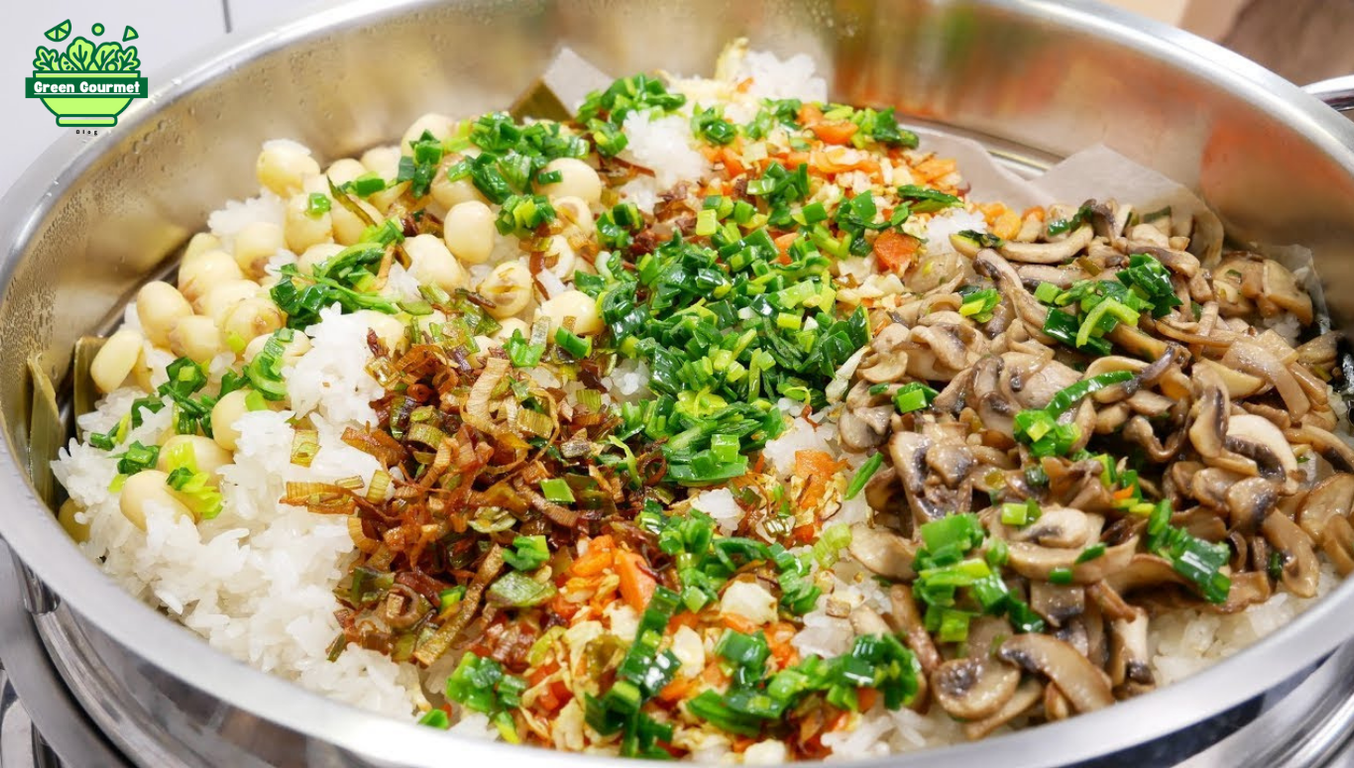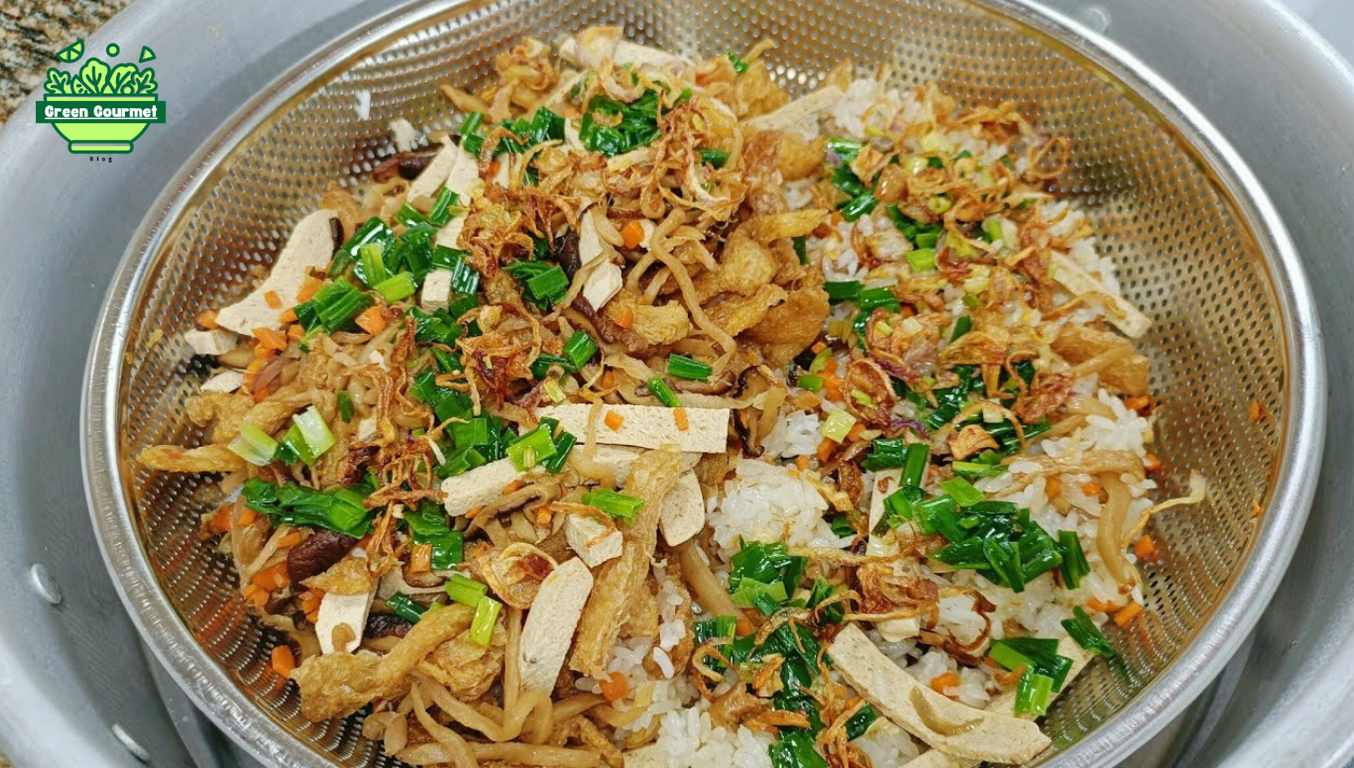How to Make Vegetarian Sticky Rice: A Delicious and Hearty Vietnamese Dish with Cultural Significance
Vegetarian Sticky Rice, known as “Xôi Chay” in Vietnamese, is a traditional dish that holds deep cultural roots in Vietnam. Often enjoyed during religious ceremonies, festivals, or as a breakfast staple, this dish symbolizes simplicity and balance. In Vietnam, sticky rice is a common element in daily meals, often paired with savory or sweet ingredients to suit the occasion. Vegetarian sticky rice, in particular, is a popular offering during vegetarian days observed by Buddhists, or as a nutritious and filling meal for those following plant-based diets.
This dish combines glutinous rice with vegetables, tofu, and flavorful seasonings, offering a balance of texture and flavor. At Green Gourmet , we’ll show you how to make Vegetarian Sticky Rice, explain its cultural significance, and offer tips on ingredient substitutions and variations to suit different tastes.
How to Make Vegetarian Sticky Rice
Ingredients:
- 2 cups glutinous rice (soaked in water for at least 4 hours)
- 1 cup mushrooms (shiitake or button, sliced)
- 1/2 cup carrots (diced)
- 1/2 cup green peas
- 1 block of firm tofu (pressed and cubed)
- 2 tablespoons soy sauce or tamari (for a gluten-free option)
- 2 cloves garlic (minced)
- 2 tablespoons vegetable oil
- 1 teaspoon sugar (optional)
- Salt and pepper to taste
- Fried shallots (optional, for garnish)
- Fresh cilantro or scallions (for garnish)
Detailed Steps with Time Breakdown:
- Prepare the glutinous rice (5 minutes prep, 30 minutes cooking):
- Soak the rice: Soak the glutinous rice in water for at least 4 hours, or overnight, to ensure a sticky texture when cooked.
- Cook the rice: Drain the soaked rice and steam it for about 30 minutes until soft and fully cooked. Fluff the rice with a fork once done.
- Prepare the tofu and vegetables (15 minutes):
- Press and cook the tofu: Press the tofu to remove excess moisture, then cut it into cubes. Fry the tofu in a pan with 1 tablespoon of vegetable oil until golden brown on all sides (about 5-7 minutes). Set aside.
- Sauté the vegetables: In the same pan, heat another tablespoon of oil. Add the garlic, mushrooms, carrots, and peas, and sauté for 5-7 minutes until the vegetables are tender. Season with soy sauce or tamari, sugar (optional), salt, and pepper.
- Mix the sticky rice (5 minutes):
- Once the sticky rice is cooked, transfer it to a large bowl and gently mix in the sautéed vegetables and tofu. Stir until everything is evenly distributed.
- Serve (immediately or within 15 minutes):
- Garnish the vegetarian sticky rice with fried shallots, fresh cilantro, or scallions for added flavor and texture. Enjoy warm as either a main course or a side dish.
Cultural Significance of Vegetarian Sticky Rice
In Vietnam, sticky rice dishes like Xôi Chay are much more than just meals—they are a part of the cultural and spiritual fabric of the country. Sticky rice is often enjoyed during festive occasions such as Lunar New Year (Tết) and is served as a symbol of prosperity and abundance. Vegetarian versions are particularly popular during Buddhist festivals, when meatless meals are prepared to honor the practice of compassion and mindfulness. Xôi Chay is also a common offering at temples and is enjoyed by people of all backgrounds for its simple yet fulfilling nature.
Ingredient Substitutions for Flexibility
If you don’t have all the ingredients listed, don’t worry—Vegetarian Sticky Rice is flexible, and you can make substitutions based on what’s available:
- Mushrooms: If shiitake or button mushrooms aren’t available, you can use portobello or oyster mushrooms for a different texture and flavor.
- Vegetables: Feel free to swap out the carrots and peas for other vegetables such as zucchini, bell peppers, or spinach.
- Tofu: If you want to try a different protein, tempeh or even seitan can be used as a substitute for tofu, adding a new layer of texture to the dish.
Variations for Different Tastes
Vegetarian Sticky Rice is incredibly versatile, and you can easily adjust the flavors to suit your personal preferences:
- Add More Flavor: For a bolder flavor, consider adding roasted peanuts, sesame seeds, or a drizzle of soy sauce or hoisin sauce.
- Make It Creamier: If you prefer a creamier, slightly sweet version, try adding a splash of coconut milk during the sautéing process for a rich and fragrant twist.
- Sweet and Savory: If you enjoy a mix of sweet and savory flavors, you can balance the savory soy sauce with a bit of brown sugar or even top the rice with sweetened coconut flakes for a delightful contrast.
Nutritional Information of Vegetarian Sticky Rice
Below is a summary of the nutritional information per portion:
| Nutrient | Amount | % Daily Value |
|---|---|---|
| Calories | 300 kcal | 15% |
| Carbohydrates | 50 g | 17% |
| Protein | 10 g | 20% |
| Fat | 6 g | 9% |
| Fiber | 4 g | 16% |
| Vitamin A | 3500 IU | 70% |
| Calcium | 40 mg | 4% |
| Iron | 2 mg | 11% |
Conclusion
Vegetarian Sticky Rice is not just a meal—it’s a reflection of Vietnam’s culinary heritage and cultural practices. Whether you’re enjoying it as part of a traditional Vietnamese celebration or as a healthy plant-based meal, Xôi Chay offers a rich, comforting experience. Its simplicity, combined with the potential for endless variations, makes it a go-to dish for anyone looking to explore the flavors of Vietnam.
Try this recipe today and enjoy the wholesome, versatile nature of Vegetarian Sticky Rice!
How to Make Rice Paper Vegan Rolls: A Fresh and Healthy Snack
How to Make Vietnamese Vegetarian Curry: A Flavorful and Nutritious Plant-Based Dish

